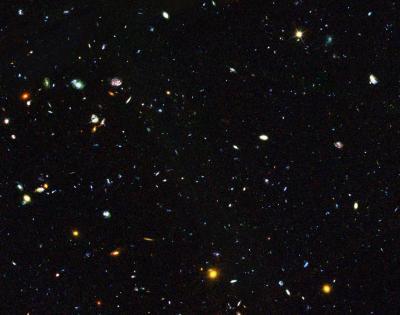New observations made using NASA's Hubble Space Telescope show that dwarf galaxies are responsible for forming a large proportion of the universe's stars.
The result supports a decade-long investigation into whether there is a link between a galaxy's mass and its star-forming activity, and helps paint a consistent picture of how galaxies grew and evolved 3.5 to 6 billion years after the beginning of the universe.
Previous studies of star-forming galaxies were restricted to the analysis of mid- or high-mass galaxies, leaving out the numerous dwarf galaxies that existed in this era of prolific star formation. Astronomers conducted a recent study using data from Hubble's Wide Field Camera 3 (WFC3) to take a further and significant step forward in understanding this formative era by examining a sample of starburst galaxies in the young universe. Starburst galaxies form stars at a furiously fast rate, far above what is considered by experts to be a normal rate of star formation. The infrared capabilities of WFC3 have allowed astronomers to finally calculate how much these low-mass dwarf galaxies contributed to the star population in our universe.

Hiding among these thousands of galaxies are faint dwarf galaxies residing in the early universe, between two and six billion years after the big bang, an important time period when most of the stars in the universe were formed. Some of these galaxies are undergoing starbursts. Credit: NASA and ESA
"We already suspected these kinds of galaxies would contribute to the early wave of star formation, but this is the first time we've been able to measure the effect they actually had," said Hakim Atek of the École Polytechnique Fédérale de Lausanne (EPFL) in Switzerland, lead author of the paper in The Astrophysical Journal. "They appear to have had a surprisingly huge role to play."
"These galaxies are forming stars so quickly they could actually double their entire mass of stars in only 150 million years -- an incredibly short astronomical timescale," says co-author Jean-Paul Kneib, also of EPFL.
Researchers say such massive growth would take most "normal" galaxies 1 to 3 billion years.
In addition to adding new insight to how and where the stars in our universe formed, this latest finding may also help to unravel the secrets of galactic evolution. Galaxies evolve through a jumble of complex processes. As galaxies merge, they are consumed by newly-formed stars that feed on their combined gases, and exploding stars and supermassive black holes emit galactic material – a process that depletes the mass of a galaxy.
It is unusual to find a galaxy in a state of starburst, which suggests to researchers starburst galaxies are the result of an unusual incident in the past, such as a violent merger.




Comments